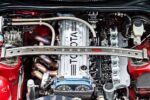Does Diesel Engines Have Catalytic Converters?
When it comes to diesel engines, there’s a lot of talk about emissions, efficiency, and regulations. One question that often pops up is whether these heavy-duty machines use catalytic converters. The short answer? Yes, but it’s a bit more complicated than that. Diesel engines operate differently than gasoline engines, and their emissions control systems reflect those differences.
Understanding Diesel Emissions
Diesel engines are notorious for producing higher levels of nitrogen oxides (NOx) and particulate matter (PM) compared to their gasoline counterparts. This is where catalytic converters come into play. In the quest for cleaner air, manufacturers have had to step up their game to meet stringent emission standards. The catalytic converter in a diesel engine is designed to reduce harmful emissions, but it operates in conjunction with other components to make the engine compliant with regulations.
Types of Catalytic Converters in Diesel Engines
Not all catalytic converters are created equal. Diesel engines typically use two main types:
- Oxidation Catalytic Converters: These are designed to reduce carbon monoxide (CO) and unburned hydrocarbons (HC) by converting them into carbon dioxide (CO2) and water (H2O).
- Selective Catalytic Reduction (SCR): This system uses a urea-based solution to convert NOx into nitrogen and water, significantly reducing harmful emissions.
Understanding these systems is crucial for anyone working on diesel engines, whether you’re a mechanic or an enthusiast. The presence of catalytic converters is a sign that manufacturers are making strides to comply with environmental regulations while still delivering the power and torque that diesel engines are known for.
Understanding Diesel Engine Emissions Control
Diesel engines have long been the workhorses of the automotive world, powering everything from trucks to buses to generators. However, with increased scrutiny on emissions and environmental impact, the question arises: do diesel engines have catalytic converters? The answer is yes, but there are nuances involved that every mechanic and diesel enthusiast should understand.
The Role of Catalytic Converters in Diesel Engines
Catalytic converters play a critical role in reducing harmful emissions produced by diesel engines. While gasoline engines primarily deal with carbon monoxide and unburned hydrocarbons, diesel engines face a different set of challenges, including NOx and particulate matter. To tackle these issues, manufacturers have developed specialized catalytic converters that work in tandem with other emissions control technologies.
Types of Catalytic Converters Used
Diesel engines typically utilize two main types of catalytic converters:
| Type | Function | Key Components |
|---|---|---|
| Oxidation Catalytic Converter | Reduces CO and HC emissions | Platinum, Palladium, Rhodium |
| Selective Catalytic Reduction (SCR) | Reduces NOx emissions | Urea solution (DEF), Catalyst |
These systems are designed to address specific pollutants, ensuring that diesel engines can meet stringent emission standards.
How Catalytic Converters Work
Understanding how these converters function is essential for anyone working on diesel engines. Here’s a breakdown:
- Oxidation Catalytic Converters: These converters facilitate chemical reactions that convert harmful gases into less harmful substances. They primarily target carbon monoxide and unburned hydrocarbons, converting them into carbon dioxide and water.
- Selective Catalytic Reduction (SCR): This system injects a urea-based solution (commonly known as Diesel Exhaust Fluid or DEF) into the exhaust stream. The urea reacts with NOx in the presence of a catalyst, converting it into nitrogen and water vapor, which are harmless.
Importance of Maintenance
Maintaining these systems is crucial for optimal performance and compliance with emissions regulations. Neglecting catalytic converters can lead to:
- Increased emissions, resulting in fines or penalties.
- Reduced engine performance and fuel efficiency.
- Potential damage to the engine if exhaust backpressure increases.
Regular inspections and timely replacements of worn-out components can save a lot of hassle down the line.
Regulatory Standards and Impact
With the rise of environmental regulations, diesel engines are under more scrutiny than ever. The EPA and other regulatory bodies have set strict limits on emissions, which has led to the widespread adoption of catalytic converters in diesel vehicles. This shift has forced manufacturers to innovate, leading to more efficient and cleaner diesel technologies.
Future of Diesel Engines and Emissions Control
The future of diesel engines is uncertain, especially with the push toward electric vehicles. However, catalytic converters will remain a critical component for the foreseeable future. As technology advances, we can expect to see even more efficient systems that further reduce emissions while maintaining the power and torque that diesel engines are known for.
In summary, diesel engines do indeed have catalytic converters, and understanding their role and maintenance is vital for anyone involved in the automotive industry. The ongoing evolution of emissions control technologies will shape the landscape of diesel engines for years to come.




0 Comments